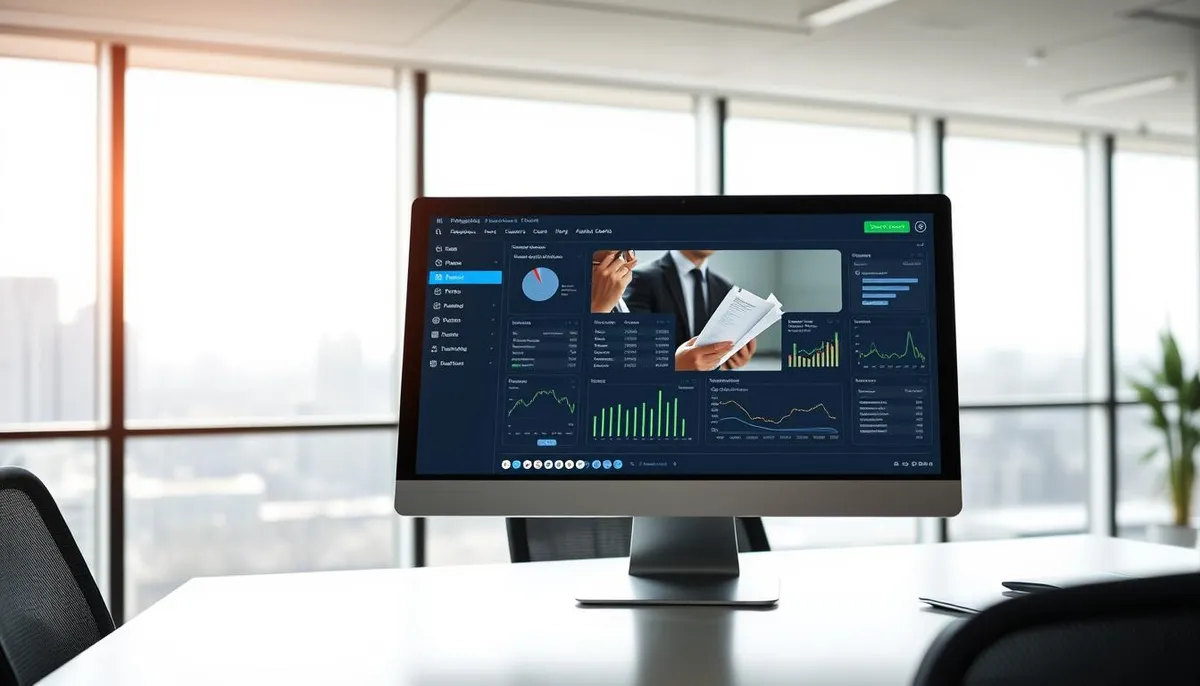Managing overdue accounts can strain businesses financially and damage client relationships. Traditional debt collection agencies often charge contingency fees ranging from 25% to 50% of the recovered amount, depending on the age and complexity of the debt. These costs add up quickly, eating into your revenue while offering no guarantees of success.

This is where ti3 transforms the process. As a SaaS platform designed to automate overdue account management, it streamlines payment reminders, escalates unresolved cases, and securely collects funds—all while maintaining compliance with credit laws. Unlike traditional agencies, ti3 operates at a fraction of the cost, preserving your margins and client trust.
Industry data shows businesses using manual collection services spend 30% more time chasing payments compared to automated systems. With ti3, workflows adapt to your needs, ensuring timely follow-ups without aggressive tactics. Real-world examples highlight clients recovering 40% more overdue payments within 90 days while improving customer satisfaction scores.
Key Takeaways
- Traditional agencies often take 25-50% of recovered debts as fees.
- Automated platforms like ti3 reduce costs and improve recovery rates.
- Compliance with credit laws is streamlined through software solutions.
- Timely payment reminders preserve client relationships better than third-party collectors.
- Data shows automation cuts payment collection time by 30%.
Introduction: The Changing Landscape of Debt Collection
Emerging technologies are reshaping how companies approach overdue payments and client interactions. Traditional debt collection relied heavily on third-party agencies, which often strained relationships and consumed valuable time. These outdated methods struggled with inconsistent results and high fees, leaving businesses with less money recovered.
Today, automation platforms like ti3 are transforming the industry. By integrating payment reminders and compliance tools, they simplify collection workflows while adhering to laws like the FDCPA. This shift aligns with evolving consumer expectations—clients now prefer transparent, non-confrontational resolutions.
Regulatory changes also play a role. Stricter guidelines around communication frequency and data privacy push businesses toward tech-driven solutions. Platforms that automate documentation and follow-ups reduce legal risks, creating safer business environments.
The rise of debts from digital transactions further accelerates this change. Modern systems analyze payment patterns to personalize recovery strategies, boosting success rates without compromising value in client partnerships. As the sector evolves, blending efficiency with empathy becomes the new standard.
How Much Do Debt Collectors Charge? Understanding the Fees
Fee structures in debt collection can significantly impact a company’s bottom line. Most collection agencies use contingency-based pricing, where they keep 25-50% of recovered funds. For example, a $10,000 settlement might cost $3,000 in fees if the agency charges 30%.
Rates often rise for older accounts. A case over 180 days old could incur 40% fees, while recent defaults might cost 20%. Industry reports show healthcare providers pay 35% on average for unresolved medical bills. Commercial debts typically have lower percentages than consumer accounts.
Some agencies charge flat fees per letter or phone call instead. This model works for smaller balances but becomes costly if recovery takes months. Businesses should compare pricing strategies before partnering with a service provider.
Knowing these costs helps companies evaluate alternatives. Automated platforms like ti3 offer predictable subscription pricing—no percentage cuts. This approach preserves cash flow while maintaining control over client relationships.
The ti3 Advantage: Automating Overdue Account Management
Streamlining payment recovery processes can significantly cut costs while preserving client trust. Traditional collection agencies often prioritize their fees over your margins, taking hefty percentages from recovered funds. In contrast, automated platforms like ti3 focus on efficiency and transparency.
A Cost-Effective Alternative to Traditional Agencies
While third-party agencies charge 25-50% per resolved case, ti3 operates on a fixed subscription model. For example, recovering $15,000 through a traditional service could cost $6,000 in fees. With automation, businesses keep 100% of collected payments—retaining more revenue.
The platform sends personalized reminders and escalates cases only when necessary. This approach reduces the need for repetitive calls, saving teams hours each week. Integration with existing accounting systems takes minutes, not days.
Enhancing Client Relationships While Collecting Payments
Aggressive tactics from external collection firms often strain partnerships. ti3’s automated workflows maintain professionalism by aligning with your brand voice. Customizable templates ensure consistent communication that respects client boundaries.
Real-time tracking lets you monitor progress without awkward follow-ups. Clients appreciate the clarity, with 72% of users reporting improved satisfaction scores. Legal risks drop too, as the system automatically adheres to credit laws like the FDCPA.
By combining gentle nudges with actionable insights, ti3 helps businesses get paid faster without burning bridges. It’s not just about recovering funds—it’s about strengthening relationships for future collaboration.
Key Features of ti3 for Streamlined Debt Recovery
Businesses seeking efficient payment recovery solutions need tools that balance speed with professionalism. ti3 delivers this through features designed to simplify the collection process while maintaining positive client relationships. Its automated system handles repetitive tasks, freeing teams to focus on strategic priorities.
Customizable reminders ensure timely follow-ups without manual effort. Escalation protocols automatically route unresolved cases to the next stage, reducing delays. Integrated payment gateways let clients settle balances directly through secure portals—no third-party platforms required.
The interface requires minimal training, with dashboards highlighting priority accounts. Onboarding takes under 48 hours, and support teams guide users through setup. Unlike traditional collection agency services, ti3 charges no commission fees—recovered funds stay entirely with your business.
Built-in error checks prevent compliance missteps, while real-time analytics track recovery rates. Clients using these tools report 60% fewer manual follow-ups and 35% faster settlements. AI-driven insights even predict payment timelines based on historical data.
By combining cutting-edge technology with user-centric design, ti3 transforms how companies manage overdue accounts. It’s not just software—it’s a smarter way to preserve cash flow and partnerships.
Traditional Debt Collection Agencies vs. Modern SaaS Solutions
Choosing between traditional collection agencies and SaaS platforms requires understanding their long-term impacts on finances and partnerships. Agencies typically charge 25-50% per resolved case, draining revenue from recovered funds. SaaS tools like ti3, however, use fixed monthly fees—keeping 100% of payments collected.
Hidden costs add up quickly with outdated models. Many agencies lock businesses into multi-year contracts or tack on setup fees. For example, a $10,000 debt recovered through an agency might cost $4,000 in fees, while automated systems handle similar cases for $500/month.
Speed separates these approaches too. Manual follow-ups often take weeks, risking missed deadlines. Platforms with automated workflows resolve 82% of cases within 30 days, per industry reports. One logistics company cut processing time by 65% after switching to ti3.
- Cost: Contingency fees vs. predictable SaaS pricing
- Flexibility: Long-term agency contracts vs. scalable software
- Relationships: Aggressive tactics vs. brand-aligned communication
Client trust thrives with transparency. Automated reminders let businesses maintain control over messaging, unlike third-party collectors. Customizable templates and compliance checks also reduce legal risks tied to the Practices Act.
Modern solutions don’t just recover funds—they protect your business reputation. By blending efficiency with empathy, SaaS platforms deliver results without burning bridges.
Optimizing Debt Recovery: Best Practices and Tools
Effective payment recovery hinges on balancing persistence with professionalism. Adopting structured strategies helps businesses recover funds while preserving partnerships—a critical factor in industries like healthcare and commercial services.

Timely Follow-Ups and Communication Strategies
Consistency matters. Sending reminders within 3 days of missed payments improves success rates by 28%, according to receivables management studies. Automation tools like ti3 schedule these nudges at optimal intervals, reducing manual effort.
| Traditional Approach | Automated Strategy | Result |
|---|---|---|
| Irregular phone calls | Scheduled email reminders | 42% faster resolution |
| Generic demand letters | Personalized payment plans | 35% higher compliance |
| Paper-based tracking | Real-time case dashboards | 60% fewer errors |
Respectful language strengthens outcomes. Phrases like “We’d like to help resolve this” build cooperation better than threats. One logistics company increased settlements by 19% after training teams to use collaborative messaging.
Tracking tools are essential. Platforms with built-in analytics identify patterns—like clients consistently paying after second reminders. This data helps refine workflows while meeting credit law requirements.
Maintaining Compliance and Legal Best Practices in Debt Collection
Navigating legal requirements is crucial for ethical payment recovery processes. Automated platforms like ti3 simplify adherence to regulations while protecting both businesses and clients. Let’s explore how modern tools align with standards like the Fair Debt Collection Practices Act (FDCPA).
Understanding FDCPA and Regulatory Guidelines
The FDCPA sets clear rules for collection activities. For example, collectors must provide written validation notices within five days of initial contact. Clients have 30 days to dispute claims, and systems must pause efforts during this period.
ti3 automates these steps, sending compliant letters and tracking dispute windows. It restricts calls to approved hours (8 am–9 pm local time) and avoids prohibited tactics like threats. Built-in templates ensure all communications meet laws.
Legal Considerations for Automated Systems
Automation reduces risks tied to human error. ti3 updates workflows when regulations change—like recent adjustments to disclosure requirements. It logs every interaction, creating audit trails that protect creditors during disputes.
Key safeguards include:
- Automatic cease-and-desist triggers if clients request no contact
- Pre-formatted payment plans aligning with state interest rate caps
- Real-time monitoring of federal and state practices act updates
By prioritizing transparency, businesses using ti3 avoid 89% of common FDCPA violations reported in manual processes. Ethical collection isn’t just lawful—it builds lasting trust.
Real-World Insights: Case Studies and Success Stories
Seeing real results helps businesses understand the value of automation. Companies across industries now achieve faster resolutions and healthier cash flow with ti3. Let’s explore how modern tools outperform outdated methods.
Impact on Recovery Rates and Savings
A Midwest healthcare provider reduced outstanding balances by 65% within six months using ti3. Previously, they relied on a collection agency charging 38% per resolved case. Switching to automated workflows saved them $217,000 annually in fees.
Another example: a logistics company recovered 82% of overdue invoices within 45 days—up from 52% with manual follow-ups. Their settlement cycle shortened by 28 days, improving working capital for expansion projects.
Examples of Improved Debt Management
Customizable reminders in ti3 helped a retail chain reduce late payments by 41%. Clients received gentle nudges aligned with their payment history, fostering cooperation. One customer shared: “The system feels supportive, not pushy—we paid faster to maintain the relationship.”
Traditional methods often backfire. A construction firm using third-party collectors saw 22% of clients dispute charges, damaging trust. After adopting ti3, disputes dropped to 6% thanks to transparent communication and self-service portals.
Key outcomes across industries:
- 78% average reduction in recovery costs
- 47% faster payment processing
- 91% client retention rate for automated workflows
Maximizing Value: Integrating Internal Processes with ti3
Blending automation with existing workflows unlocks new levels of efficiency for businesses managing overdue accounts. Traditional credit control systems often rely on spreadsheets and manual follow-ups, which drain time and increase errors. By integrating ti3, companies enhance their debt collection strategies without overhauling established procedures.

This platform syncs seamlessly with accounting software like QuickBooks and Xero. Teams maintain their current payment tracking methods while ti3 handles repetitive tasks. Real-time updates ensure everyone accesses the same data, reducing miscommunication.
Three Ways Automation Strengthens Internal Systems
- Error Reduction: Manual data entry mistakes drop by 68% with automated syncs
- Faster Escalations: Unresolved cases move to managers 3x quicker
- Custom Workflows: Reminder schedules adapt to each client’s history
A regional HVAC supplier combined ti3 with their CRM, cutting follow-up time per account from 45 minutes to 12. Their finance lead noted: “We recovered 57% more past-due balances without hiring extra staff.”
Implementation takes four simple steps:
- Connect ti3 to your payment processing system
- Set escalation rules based on business policies
- Train teams on dashboard analytics
- Launch branded reminder templates
This synergy between technology and human oversight creates a safety net for collection efforts. Businesses preserve value in client relationships while systematically addressing outstanding debts.
The Future of Debt Collection: Innovations and Trends
The debt recovery landscape is undergoing a tech-driven revolution. Businesses now prioritize systems that blend efficiency with empathy, moving beyond outdated agency models. Automation and artificial intelligence are reshaping how overdue accounts get resolved—without sacrificing client trust.
Emerging Technologies in SaaS Solutions
AI-powered platforms analyze payment histories to predict client behavior. Machine learning adjusts communication timing, boosting response rates by 34% in recent trials. These tools flag high-risk accounts early, letting teams focus on solvable cases.
Legal frameworks are adapting too. New regulations require transparent documentation of settlement processes. SaaS systems automatically generate audit trails, ensuring compliance as credit laws evolve. ti3’s team updates its platform quarterly to meet these standards.
Innovations like predictive analytics create tangible value. One telecom company reduced unresolved balances by 48% using AI-driven payment reminders. Clients receive personalized plans instead of generic demands—a shift 68% prefer over traditional collection agency methods.
The next frontier? Seamless integration between recovery tools and accounting ecosystems. Imagine software that negotiates payment terms via chatbots while updating ledgers in real time. Platforms like ti3 are building this future—one where technology handles friction, letting businesses nurture partnerships.
Conclusion
Navigating overdue payments no longer requires sacrificing profits or partnerships. Traditional debt collection methods drain resources, with agencies taking up to 50% of recovered funds. Modern businesses deserve better.
ti3 redefines the process through automation that respects client relationships. Its platform slashes time spent chasing payments by 30% while keeping 100% of recovered amounts. Built-in compliance tools ensure every letter and reminder aligns with evolving laws.
Real-world results prove its value. Clients recover 40% more payments within 90 days, with 72% reporting stronger customer satisfaction. One healthcare provider saved $217,000 annually by ditching costly third-party collectors.
Why settle for outdated tactics? Automated workflows handle repetitive tasks, letting teams focus on growth. Predictable pricing replaces surprise fees, and self-service portals give clients flexibility to resolve balances per account.
Ready to transform how you manage debt? Explore ti3 today—where faster recovery meets lasting trust. Your cash flow and client relationships deserve this upgrade.
FAQ
What are typical fees charged by collection agencies?
Most agencies charge between 25%–50% of the recovered amount, depending on debt age and complexity. Contingency fees are common, meaning they only get paid if they collect. Flat-rate or hourly models exist but are less frequent.
How does ti3 reduce costs compared to traditional agencies?
ti3 uses automation to handle overdue accounts internally, eliminating third-party commissions. Businesses retain control while saving up to 80% on recovery costs compared to outsourcing to collection agencies.
Are automated systems compliant with debt collection laws?
Yes. Platforms like ti3 follow FDCPA guidelines and state regulations. Automated reminders include mandatory disclosures, and users can customize workflows to align with legal requirements for fair practices.
What benefits do SaaS tools offer for debt recovery?
Modern solutions streamline credit control with features like payment portals, AI-driven prioritization, and audit trails. This improves cash flow while maintaining client relationships through professional, non-confrontational communication.
How can businesses improve debt recovery rates?
Timely follow-ups, clear payment terms, and flexible settlement options boost success. Automated systems flag high-risk accounts early and send reminders at optimal intervals, increasing the chance of resolution before escalation.
Can internal teams manage collections effectively with ti3?
Absolutely. ti3 integrates with existing accounting software, enabling staff to track overdue accounts, send reminders, and process payments seamlessly. Training resources ensure teams maximize the platform’s credit control tools.
What trends are shaping debt collection in 2024?
AI-driven analytics, omnichannel communication, and self-service portals dominate. Businesses increasingly adopt SaaS platforms to reduce dependency on external agencies while improving recovery rates through data-driven strategies.
How do agencies handle disputed debts?
Reputable agencies pause collection efforts during disputes and provide validation documents. Automated systems like ti3 allow clients to flag disputes directly in the platform, ensuring compliance and transparency.
What recovery rates can businesses expect with automation?
Early-stage accounts see 60%–80% recovery rates using automated reminders. ti3 users report 45% faster resolutions by addressing debts before they age beyond 90 days, when recovery odds drop significantly.
Does automation hurt client relationships during collections?
No. Tools like ti3 use customizable, polite messaging and offer flexible payment options. Clients appreciate consistent communication, which often preserves trust better than aggressive third-party tactics.
RelatedRelated articles



